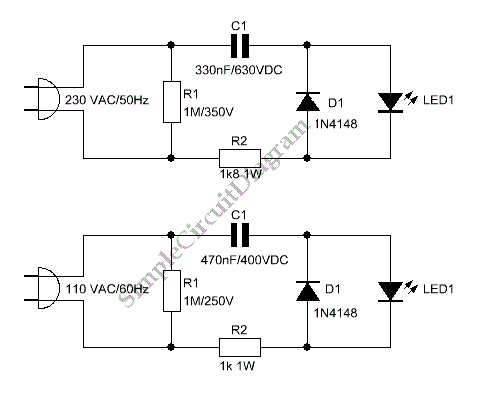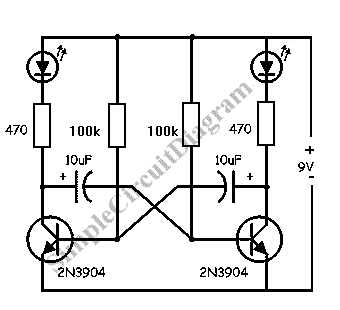Single and Two Cell White LED Drivers Without Inductors
Three inductor-free circuits that allow a white LED or UV LED to be driven from one (1.5 volt) or two flashlight cells (3 volts total) are described.
The circuits on this page are:
The two cell (3 volt) circuit four transistors.
The simple single cell (1.5 volt) circuit requires six transistors, but it isn't as bright as the two cell circuit.
The higher output single cell (1.5 volt) circuit requires 13 transistors, but it is as bright as the two cell circuit.
A Simpler and more efficient circuit that uses an inductor is described on THIS PAGE.

(Above) A battery operated LED light, powered by a single carbon zinc
AA cell is shown above. It should be easy to improve upon the
industrial design of the black plastic case with a little work. With
an alkaline cell, battery life would be 20 to 30 hours. There is a
small ON/OFF slide switch on the top of the case.
right 2005 Richard Dwight Cappels www.projects.cappels.org

(Above) Higher Output Single Cell (1.5 volt) Pulse Boost LED circuit in an enclosure. In a world without
a enclosure tooling budget, one uses what one can find. This is quite a bit brighter than the simpler single
cell circuit. This one has a small slide sitch which is mounted near the battery, to turn it on and off.
The problem with driving White and UV LED's
The operating voltage of white LEDs coupled with my emotional need for low cost for a given function, motivates me to make LED drivers suitable for battery operated lanterns that can run from a small number of cells. White and Ultraviolet LEDs available at the time of this writing, require higher voltages than colored LED's. In the case of the ones I bought most recently, from 2.8 to 4 volts, depending upon operating current and the individual device.
A 006P 9 volt transistor radio battery can drive a 4 volt LED quite easily if the correct resistor is placed in series. The 9 volt transistor radio battery is among the most expensive of the common primary batteries, and has a rather low energy capacity, so it does not seem to be a practical choice for my uses.
Primary batteries, such as alkaline and carbon zinc flashlight cells are priced by the cell rather than the available energy. For example, a flashlight D cell costs about twice what penlight AAA cell of the same brand and similar construction does, but the D cell is capable of delivering much more than twice the energy, so the cost of light is much lower with the D cell.
Unfortunately, three or more of these approximately 1.5 volt cells are needed to directly light a white LED. This solution is good for some applications, but is not desirable in all applications, such as rechargeable lights, where one cell would be adequate and would significantly lower cost. Another place multiple cells is a problem is in compact lamps where the space is a problem.
To me, the AA cell seems to be a good tradeoff among size, weight, energy capacity and cost. This was the reason behind my first LED power supplies based on blocking oscillators. These work very well and are pretty efficient -even the one that's built into the lamp base and runs at a couple hundred kilohertz.
Many people seem to have trouble finding the parts to make the inductor for the blocking oscillator. Ferrite cores are exotic to many, and they seem to have become more difficult to obtain in the last few years. Thus, I decided that this project would not use any inductors, and would instead use readily obtained components. The circuits described here can be from simple discreet components, which means that the components will be more easily obtainable to some and it gives the builder an opportunity to customize the design to her or his own needs.
The three white LED power supply circuits described here are based on a simple pulse boost circuit. The single cell version was made from the two cell version by adding an additional boost stage, and the Higher Output Single Cell circuit was made by adding an additional pulse boost stage and some peak detectors to the LED is operated from direct current. Though it cannot be seen from the pictures below, the two cell version produced a brighter light than the simple single cell circuit and the Higher Output Single Cell circuit is at least as bright as the two cell circuit.
 Copyright 2005 Richard Dwight Cappels www.projects.cappels.org
Copyright 2005 Richard Dwight Cappels www.projects.cappels.org
(Above) A Two Cell (3 volt) Pulse Boot LED driver circuit uses four transistors.
It was powered from a bench top power supply.
 Copyright 2005 Richard Dwight Cappels www.projects.cappels.org
Copyright 2005 Richard Dwight Cappels www.projects.cappels.org
(Above) Single Cell (1.5 volt) Pulse Boost LED driver circuit uses six transistors.
The single cell board was made by adding two PNP transistors, three resistors and
a capacitor to the Two Cell circuit.

(Above) Higher Output Single Cell (1.5 volt) Pulse Boost LED driver circuit uses thirteen transistors
and is as bright as the 3 volt drive circuit. Some of the additional transistors serve to increase the
efficiency of the voltage multiplier stages over that of the simpler circuits. A word of caution about
soldering to button cells. I don't recommend it as they tend to explode under the heat of the soldering
iron. It is far better to use a holder. When I soldered this one, I used a hot, well-tinned iron, lots of
active flux, and let the cell cool between steps in the soldering process. I wore safety goggles over my eyeglasses.
After the picture was taken, I connected the circuit to an AA cell battery and put it in the frosty plastic
enclosure shown near the top of this page.















